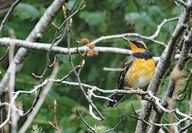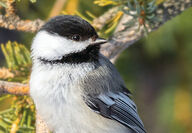Sorted by date Results 1 - 6 of 6

As Alaska's brief summer winds down, the daylight hours lessen and the weather is more often blustery and rainy. This change signals the migratory birds who spent the summer in Alaska finding mates, defending territories, building nests, and raising young, to begin their journey south. Migratory birds face many challenges along their route. They may become disoriented by light pollution and collide with the windows of tall buildings. They have to avoid predators when they stop to refuel and...

Imagine being a tiny songbird who flies across thousands of miles of boreal forest, facing frigid temperatures and snowstorms, searching for the next crop of birch or spruce seeds. All the while calling joyously to your flock mates as if you didn't have a care in the world. Look at your birdfeeder or spruce trees, and you'll likely see a flock of songbirds - common redpolls, pine siskins, or white-winged crossbills. In some winters, you may see an unexpectedly large number of them. Redpolls,...

As we near the end of summer, many of us are planning for the winter months ahead: hunting, picking berries, canning vegetables, and freezing summer's food bounty. And the birds who will spend the winter with us are doing the same. Many birds that live in Alaska year-round have clever strategies for ensuring they have enough food to get them through our long, cold winters. If you watch closely, you can see them gathering and caching food at this time of year. Some are scatter hoarders, hiding...

It is midnight, and hunger strikes. You creep down to the refrigerator to find something to eat. You pick up a container, peer inside, and decide there are better options in the cabinet. You decide on peanut butter and crackers. The glass jar of natural peanut butter has yet to be opened, so you struggle to break the seal and twist off the lid. Next, you select the best container to store the peanut butter in after stirring it. This scenario isn't unique to humans. Birds must also figure out...

This time of year, many of us like to sit back with a warm cup of tea and watch the birds that come to our feeders. Chickadees, nuthatches, woodpeckers and occasionally redpolls and pine grosbeaks partake of the free food. But what about the other birds that stay in Alaska through our long, often cold winters? The ones that don't visit bird feeders, like golden-crowned kinglets, American dippers or northern goshawks? The diminutive golden-crowned kinglet stays in Alaska and can survive temperatu...

Alaska has a diverse range of habitats and ecosystems that support over 534 different species of birds. Most of these birds are migratory and travel great distances to spend the brief summers here to nest and raise young. But some birds live in Alaska year-round, despite our long winters and extremes in weather, including a few of our most visible and spectacular birds - raptors. There are 22 raptors that regularly make Alaska their home, all of them incredible in their abilities to survive....